|
|
The Snohomish Health District has released three new reports, providing more insight into COVID-19 transmission, outbreaks and vaccination efforts in Snohomish County.
A monthly report analyzing race and ethnicity data for COVID-19 cases was updated through February 12. The data show that Native Hawaiian/Pacific Islanders have the highest case rate in Snohomish County, which was 5.2 times higher than non-Hispanic Whites. COVID-19 infection rates are also higher for Latinx (3.6 times), Blacks (2.8 times), and American Indian/Alaska Native (2.5 times), compared to non-Hispanic Whites.
Hospitalization rates were also higher for Native Hawaiian/Pacific Islanders (4.0 times), American Indian/Alaska Native (2.2 times), and Latinx (1.9 times), compared to non-Hispanic Whites.
Death rates are higher for Native Hawaiian/Pacific Islanders (2.6 times), compared to non-Hispanic Whites. A higher death rate (1.6 times) was also noted for American Indian/Alaska Native, but statistical analysis could not exclude that this difference was due to chance. It is important to note that once someone is diagnosed with COVID-19, the risk of death in Snohomish County is similar across groups. This suggests that increased exposure to the virus—not a biological difference in susceptibility—drives the higher rate of poor outcomes due to COVID-19 seen in across race and ethnicity groups.
COVID-19 Case Rates per 100,000 by Race and Ethnicity
(March 2020 – February 12, 2021) – Snohomish County
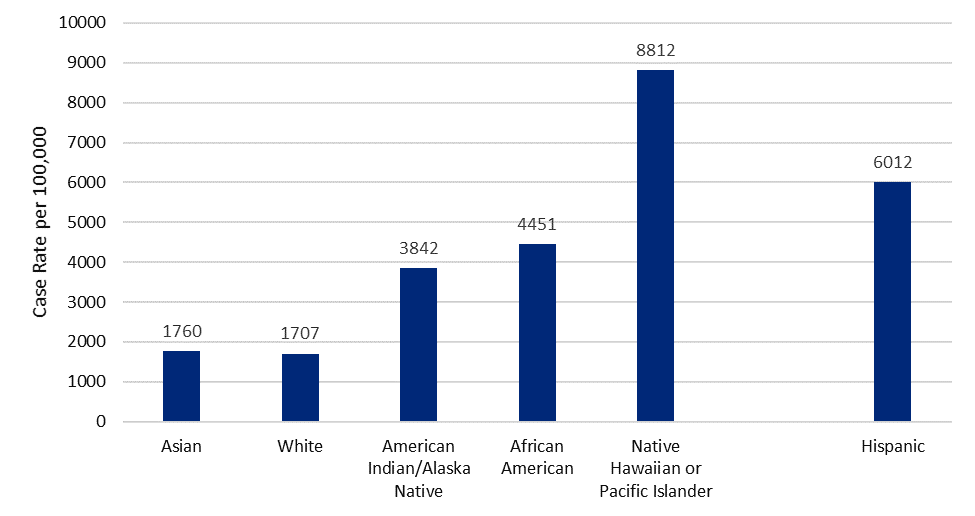 An updated Snohomish County COVID-19 Outbreak report looked at data through February 15. There were 177 healthcare associated outbreaks which accounted for 1,872 cases of COVID-19. Over half were in long-term care facilities (skilled nursing and assisted living). The next most common site of healthcare associated outbreaks is adult family homes. There were 463 non-health care outbreaks involving 4,902 cases. Leading settings were retail locations, followed by manufacturing, construction sites, restaurants, and childcare facilities.
COVID-19 Outbreaks by Site
(December 17, 2020 – February 15, 2021) – Snohomish County
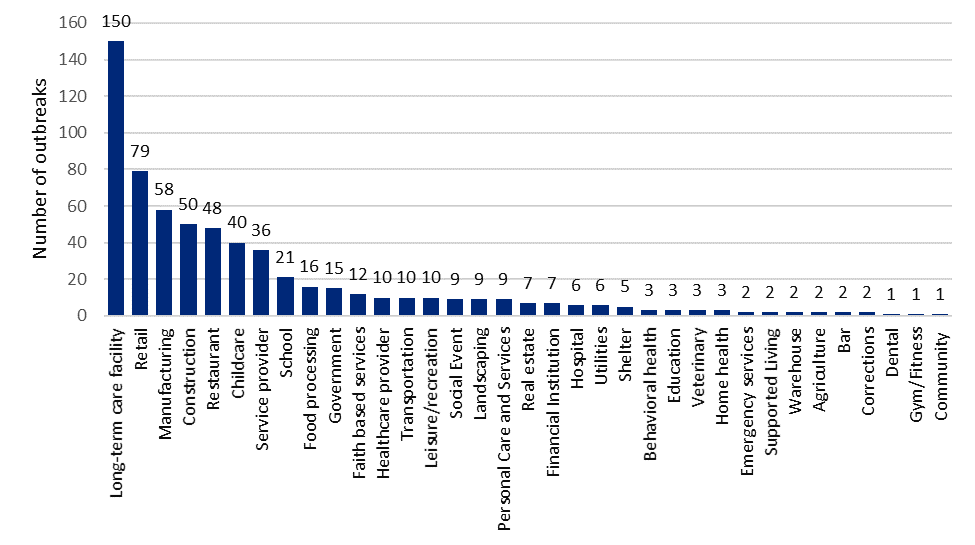 The third report is the first look at demographic data for vaccines administered through February 14. The 86,966 Snohomish County residents vaccinated up to that point represent 10.4% of the county’s total population. Sixty-one percent were female and 46 percent were people 65 years of age and older. These figures reflect a larger number of women in healthcare, along with older adults, both groups that have been prioritized in the early phases of the emergency vaccination effort.
Overall, 31 percent of Snohomish County adults that are 65 years of age or older had been vaccinated. When looking at race and ethnicity, the highest vaccination rates have been in Native Americans and Native Hawaiian/Pacific Islander.
Latinx vaccination rates are far below those seen in other groups, 38 percent of that for non-Hispanic Whites.
“This gap could be due to differences in the age distribution compared to other race and ethnicity groups, and possibly less employment in the healthcare sector,” said Dr. Chris Spitters, Health Officer for the Snohomish Health District. “However, these findings also raise concern about our Latinx communities’ trust in and access to vaccination. We’ll be working with partners in Snohomish County to help see that gap close as vaccination efforts progress to include essential workers and other phases moving forward.”
COVID-19 Vaccination Rates per 100,000 by Race/Ethnicity
(December 17, 2020 – February 14, 2021) – Snohomish County
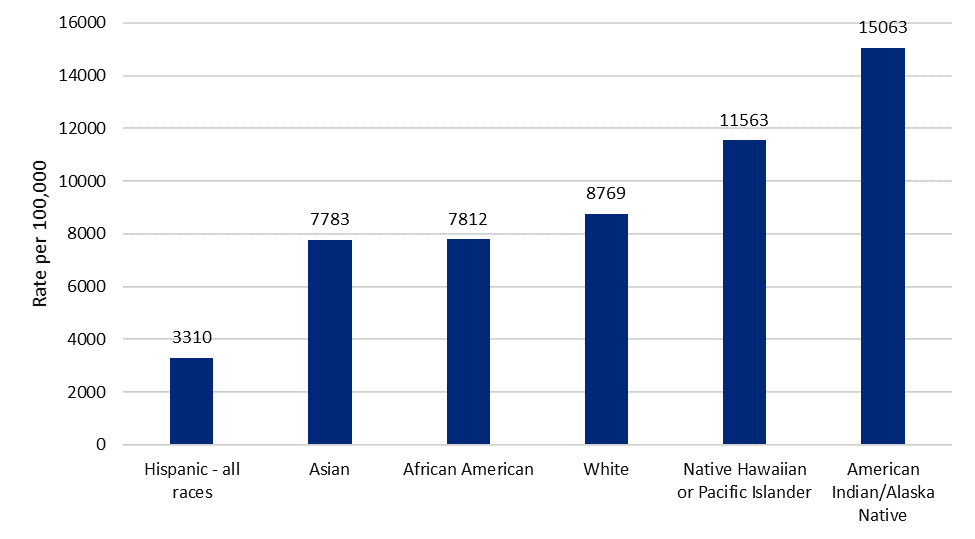 The Snohomish Health District will continue to update this information monthly, as well as utilizing the data to help inform Snohomish County Vaccine Taskforce planning and operations moving forward to promote fair and equitable access to vaccine for those who wish to get it.
Read the full release.
|
|
|
The reported number of COVID-related deaths in Snohomish County jumped from 498 on Tuesday to 539 on Wednesday. This is due to a monthly reconciliation of data, not a sudden surge in fatal cases.
Preliminary death data is reported daily on weekdays. Roughly once per month, the data team at the Snohomish Health District reconciles that death data with other records. This can result in changes to the preliminary reported numbers.
Updated charts, including deaths by week, will be released in the next bi-weekly report published on Monday.
Put another way, Snohomish County in February passed the grim milestone of 500 COVID deaths. The first COVID death in the county was reported March 2, 2020.
The U.S. earlier this week surpassed 500,000 COVID deaths.
|
|
|
Progress continues in providing COVID-19 vaccines in Snohomish County. While there have been challenges, particularly with supply, enough people now are fully vaccinated to fill Angel of the Winds Arena to capacity nearly three times over. bit.ly/snocovaccine #InItTogether
Facebook
Twitter

|
|
|
As announced last week, the Snohomish Health District has been monitoring patient volumes and positivity rates at the community-based testing sites to determine if further test site consolidation is feasible. These moves allow staff to be reallocated to support vaccine site operations.
The schedule through March 7 is as follows:
- 3900 Broadway site in Everett – seven days a week from 9 a.m. to 4 p.m.
- Lynnwood Food Bank site at 5320 176th St SW – open Monday, Tuesday, Thursday and now Saturdays from 9 a.m. to 4 p.m.
- Evergreen State Fairgrounds in the front parking lot off of 179th Ave SE in Monroe – open Monday-Thursday from 9 a.m. to 4 p.m.
- Sultan Elementary School site at 501 Date St – this location is a walk-up test site, and is open Fridays from 9 a.m. to 3 p.m.
Testing is by appointment and registration is now open at www.snohd.org/testing. Those without internet access or needing language assistance can reach the Health District’s call center at 425.339.5278. The call center is staffed 8:30 a.m. to 4:30 p.m. Monday through Friday. Callers after hours or on weekends can leave a message, which will be returned on the next business day.
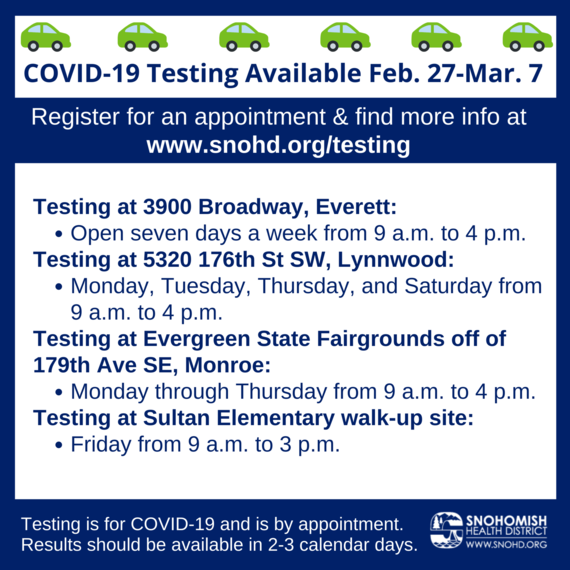
|
|
|
Snohomish County Council Chair Stephanie Wright and Vice Chair Megan Dunn will be co-hosting a regional Town Hall Meeting regarding vaccines and vaccine distribution in Snohomish County on Tuesday, March 2 from 4:30-5:30pm. Opening remarks will be provided by Snohomish County Executive Dave Somers, and panelists will include Dr. Chris Spitters and Shawn Fredrick from the Snohomish Health District, Jason Biermann from Snohomish County Department of Emergency Management, and Rochelle Lubbers from the Tulalip Tribes. The event is free and anyone from the public is welcome to join via Zoom at http://bit.ly/SnoCoTownHall.
“Snohomish County is staying focused on vaccinating our residents as safely and quickly as possible,” said Snohomish County Executive Dave Somers. “The limits to date have been the lack of adequate vaccine supply, but as our supplies increase, we will be ready to expand our capacity. We will continue to stay focused on doing our part until everyone in the county who wants to be vaccinated has been.”
“One of the most important assets we have in combating this pandemic is a well-informed public,” said Council Chair Stephanie Wright. “Listening and learning from each other is key to reducing our transmission numbers and working towards long-term economic recovery.”
“I have been hearing a lot of frustrations and concerns from constituents who have been having trouble accessing the vaccine. I’m glad to host this Town Hall to help showcase the hard work that the county has been doing to prepare for vaccine distribution,” Said Council Vice Chair Megan Dunn. “I remain hopeful that federal supply of vaccine can catch up with local demand soon. Snohomish County is ready.”
Co-hosts for this event include the Tulalip Tribes, Washington State Representatives Mike Sells, Strom Peterson, and Emily Wicks, Everett City Councilmember Scott Bader, and Mukilteo City Councilmember Elisabeth Crawford. People who would like to attend this Town Hall can join at http://bit.ly/SnoCoTownHall. Attendees are encouraged to submit questions ahead of time to Paula Rhyne at paula.rhyne@snoco.org. The event will be recorded and available to watch at a later date.
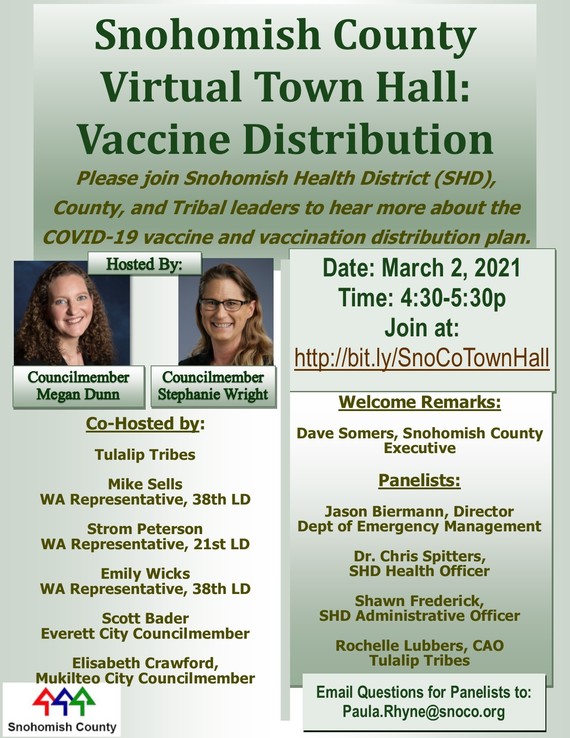
|
|
|
Gov. Jay Inslee, noting a dramatic decrease in case rates over the last two months, on Thursday announced a pause on the Healthy Washington – Roadmap to Recovery. That means no regions will move backward or forward in the reopening plan for at least the next two weeks, he told an afternoon press conference.
Inslee said that this pause will be used by his office and the Department of Health to develop with scientists, government agencies, elected officials, businesses, and other organizations a Phase 3 for the reopening plan. The team will evaluate and incorporate information on vaccinations and variants as well successful efforts in other parts of the country and world. The governor did not put a timeframe on the development of a Phase 3 framework, noting that it will take time to review the science and data that is currently coming in.
The Washington State Department of Health will not be publishing a new Roadmap to Recovery report at this time, leading the Snohomish Health District to pause publication of its regular snapshot reports.
Watch the press conference on TVW.
|
|
|
Deadline to apply for a City of Marysville grant to fund public service activities that prepare, prevent and respond to the spread of infectious disease such as COVID-19 is 4 p.m. Monday, March 1.
The city will award up to a total of $180,443 for eligible activities that:
- Support new businesses or business expansion to create jobs and manufacture medical supplies necessary to respond to infectious disease;
- Carry out job training to expand the pool of healthcare workers and techs to treat disease within the community;
- Provide testing, diagnosis, or other services at a fixed or mobile location;
- Provide equipment, supplies, and materials necessary to carry out a public service;
- Deliver meals on wheels to quarantined individuals or individuals who need to maintain social distancing due to medical vulnerabilities (must be a quantifiable increase to services currently being provided); or
- One-time emergency rental/mortgage assistance, for a period not exceed three months, to those experiencing loss of income/inability to pay rent or mortgage due to COVID-19.
Find eligibility details and the application form at https://www.marysvillewa.gov/434/Community-Development-Block-Grants
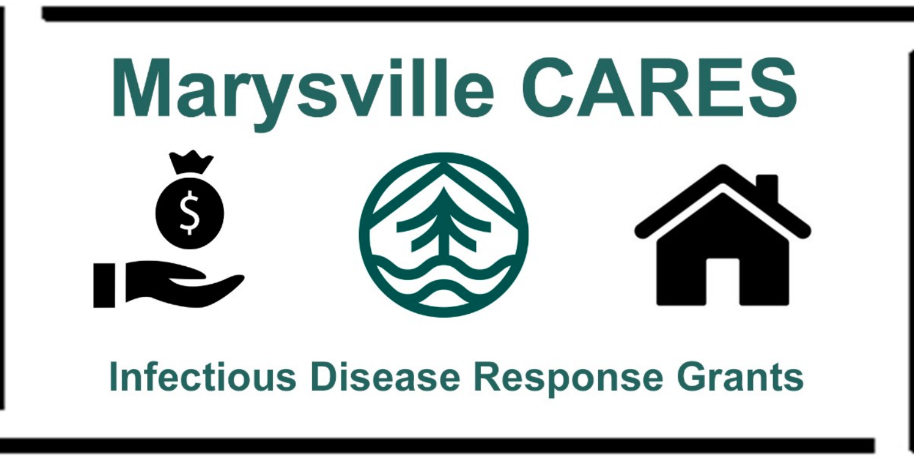
|
|
|
Community Transit wants to know what you think about riding transit during COVID-19 so they can learn how it may have changed your use of public transportation. The survey is brief, anonymous and open until March 7. You could win one of five $100 gift cards for your participation.
Your feedback will help CT meet your public transportation needs, improve transportation options, and improve communications with all communities they serve.
Take the survey here: https://bit.ly/37GpQCY
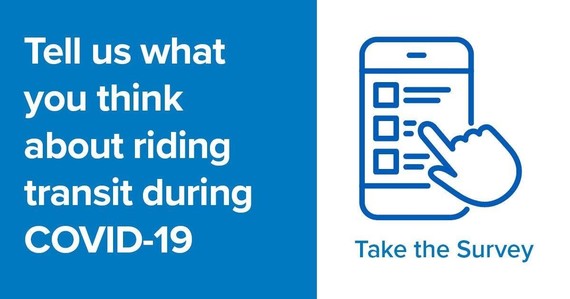
|
|
|
More schools in Snohomish County are starting to welcome back students. Make sure you are keeping up on the latest from your local district by following these tips.
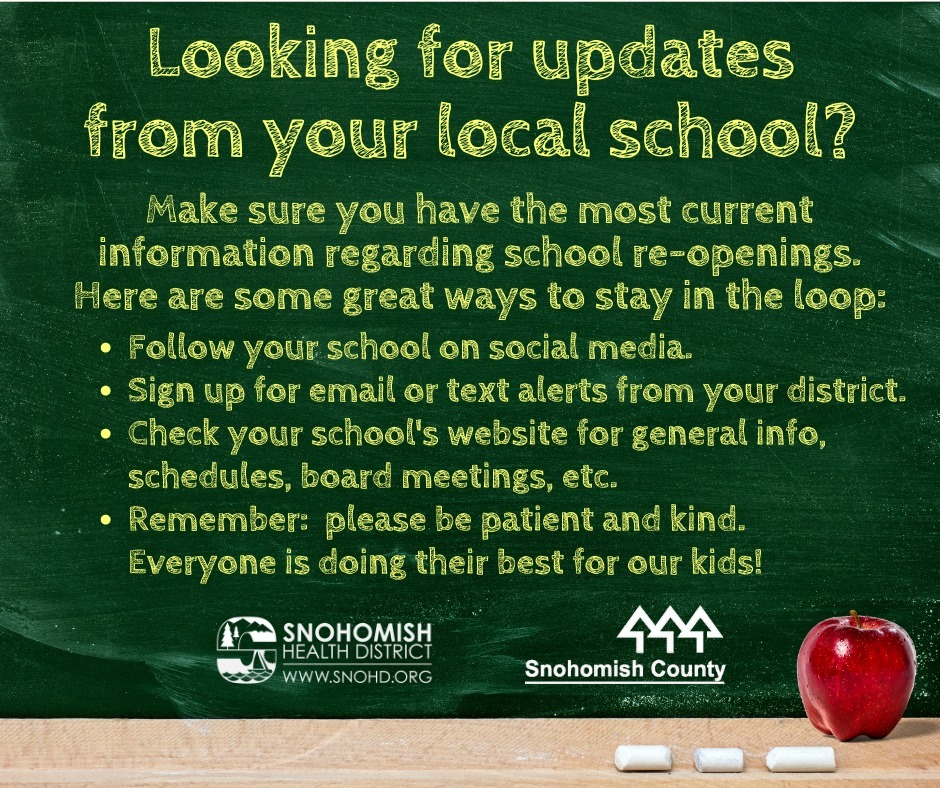
|
|

The state Department of Health and the Institute for Disease Modeling released a new report, the fourth in a series, that explores how to minimize COVID-19 introductions in schools, and what can be done to mitigate its spread within schools and the larger community.
Key findings from IDM’s new report:
-
The rate at which COVID-19 is introduced in the classroom is proportional to the prevalence of COVID‐19 in the community. For a given school population over a given period of time, a simple calculation based on these results can estimate the number of COVID-19 introductions a school can expect (within the limits of the model’s assumptions).
-
K‐5 is at lower risk of introductions compared to middle and high schools, and the K‐5 phase‐in approach has a 25% lower introduction rate compared to a full 5‐day‐per‐week schedule.
-
High schools are more likely to have large outbreaks than elementary or middle schools due to reduced ability to maintain stable cohorts or groups of students, larger school size, and older students who are likely more susceptible to infection.
-
Vaccines against COVID-19 provide high levels of protection to recipients, but because students are likely to be a main source of introductions, vaccinating all staff will not prevent COVID from entering schools. Vaccinating staff can also reduce the size of typical outbreaks, but the impact is less than other countermeasures.
-
Few tools are available to reduce the introduction rate, although high‐frequency diagnostic screening of asymptomatic students, teachers and staff can reduce the introduction rate by as much as 50% where and when practical.
-
Many interventions can limit transmission among students, teachers, and staff within schools and outbreaks will be small if countermeasures are sufficient to limit in-school transmission.
This new analysis by IDM entitled “Stepping Back to School” uses a detailed computer model of COVID‐19 to explore the interplay between disease transmission inside and outside schools in three steps: 1) introduction to school, 2) spread within school, and 3) exportation from schools. This step‐by‐step approach enables new insights into risks and mitigation strategies that could be applied to different schools and community contexts here in Washington State and elsewhere.
Closing schools early in the COVID-19 pandemic has been associated with significant reductions in disease transmission at the community level, yet K-12 schools that have returned to in-person learning have reported few outbreaks. Here in Washington State, there have been only 84 reported events of in-school transmission out of 200,000 students engaged in on-site instruction through December. Three hundred and five (305) cases were linked to these clusters. This is a remarkably low rate of transmission with a median size of three people involved in each.
See the full press release for more information.
|
|
|

The state Department of Health on Friday released the latest statewide situation report on COVID-19.
Report findings include:
-
While trends in cases, hospitalizations and deaths are largely continuing to decline, some concerning signs remain. In particular, the state is detecting increasing numbers of cases of the B.1.1.7 variant that spreads more easily than other strains.
-
COVID-19 transmission decreased in January following peaks in late December, but the reproductive number (Re) has remained close to 1 in both eastern and western Washington. The best estimate of the reproductive number (how many new people each COVID-19 patient will infect) on Feb. 5 was 0.71 in western Washington and 0.88 in eastern Washington. The goal is maintaining a reproductive number well below one—meaning COVID-19 transmission is declining—for a substantial amount of time.
-
Case rates have remained high across the state but continue moving in the right direction. Only nine of 39 counties had rates above 200 new cases per 100,000 people over the two-week period ending on Feb. 11. No counties had rates above 500 new cases per 100,000 people.
-
The estimated percentage of people with active COVID-19 infections is only slightly lower than the peak estimates during the first two waves of disease in late March and mid-July 2020. The best model-based prevalence estimate as of Feb. 5 was 0.16%. That means we still have a lot of infected people who may need health care and could be spreading the virus to others.
-
Total hospital admissions have steadily declined since early January, with a slight flattening beginning in early February. While this trend is going in the right direction, hospital admissions as of early February were still only slightly lower than the highest levels in the first two waves of disease in 2020.
-
The number of hospital beds occupied by confirmed or suspected COVID-19 patients was steadily declining across the state as of Feb. 22. This trend follows a late fall spike that flattened in early to mid-January. The number of ICU beds occupied by COVID-19 patients has varied more, but has generally been declining since January.
See the full press release for more information.
|
|
|
|
Unemployment claims in Snohomish County nudged up 1.6% during the week of Feb. 14 through Feb. 20, the Employment Security Department said Thursday. There were 1,410 claims filed in the county, up 23 from the week before, according to state data.
Statewide, there were 14,043 initial regular unemployment claims, up 3.2% from the prior week.
Overall, claim levels remain nearly 1.5 times where they were last year at this time, prior to the most serious disruption from COVID-19 pandemic.
See the full press release for more information.
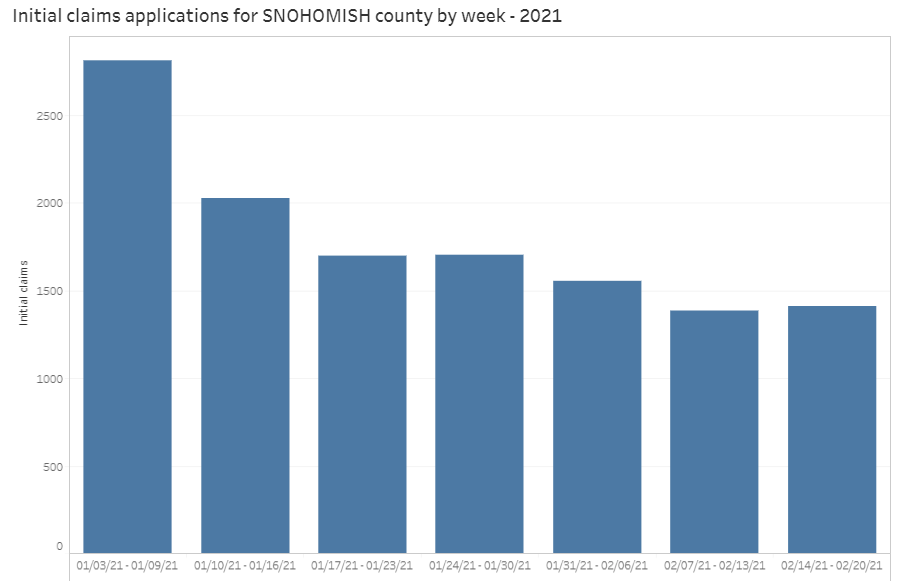
|
|
|
The past year has been a tough one for us all. The massive changes in our work, home, school, and social lives have taken a measurable toll on our everyday health. Some of us responded to feelings of a loss of control by adopting new habits. Like many of us, I tried to cope with the endless changes and the daily monotony by returning to some familiar habits — along with their side effects.
One of these old habits was to put off seeing the doctor. Whether you see a nurse practitioner, physician’s assistant, or a doctor, your primary care provider is likely hoping to see you soon. Without regular check-ups, we can find that our blood pressure, blood sugar, and blood cholesterol numbers have crept up to unhealthy levels. Especially, since we’ve been required to change our healthy habits that might have kept those numbers in check.
This blog explores some ideas that may help make that appointment and get back on track with taking care of yourself. BTW: February is heart health awareness month.

|
|
|
Cumulative from Jan. 2020 through Feb. 26, 2021.

|
|
|
ESSENTIAL LINKS AND PHONE NUMBERS FOR UP-TO-DATE INFORMATION
|
|
|
|
|